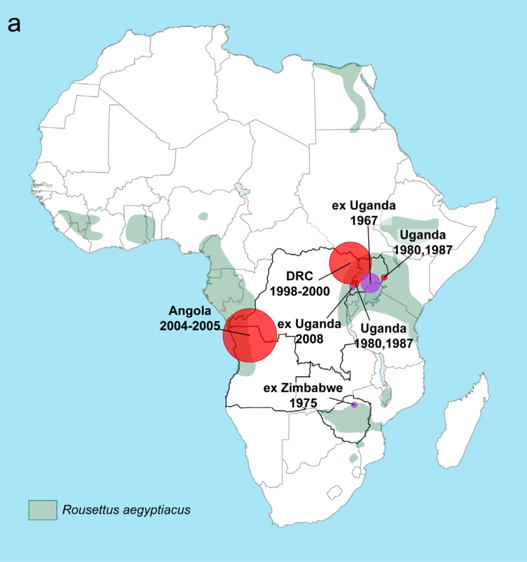The Marburg virus, a highly virulent pathogen belonging to the Filoviridae family alongside the Ebola virus, has re-emerged in recent years, triggering outbreaks that remind the world of its lethality. This virus, responsible for Marburg Virus Disease (MVD), causes severe haemorrhagic fever with a mortality rate often exceeding 80%. While MVD is less well-known than Ebola, its outbreaks pose a significant threat to public health, particularly in sub-Saharan Africa, where most recent cases have been reported.
Virus structure and transmission
Marburg virus is a zoonotic pathogen, meaning it is transmitted from animals to humans. The primary reservoir of the virus is the Egyptian fruit bat (Rousettus aegyptiacus), commonly found in caves and mines across Africa. Human-to-human transmission occurs through direct contact with the bodily fluids of infected individuals, contaminated surfaces, or medical equipment. In nosocomial (hospital) settings, the virus spreads rapidly without proper infection control measures.
Structurally, the virus is filamentous and encodes seven proteins, including the glycoprotein essential for attachment and entry into host cells. Once inside the host, it triggers a cascade of immune dysregulation, leading to systemic inflammation, vascular damage, and haemorrhagic manifestations, which characterize the disease’s deadly course.
Clinical symptoms
The incubation period for MVD ranges from 2 to 21 days. Early symptoms are non-specific and resemble other febrile illnesses, including headache, muscle pain, and high fever. However, as the disease progresses, patients rapidly develop more severe symptoms such as abdominal pain, vomiting, diarrhoea, and haemorrhaging from mucosal surfaces (nose, gums) and puncture sites. Multi-organ dysfunction, including liver failure, renal impairment, and shock, often leads to death in severe cases.
Pathologically, the Marburg virus targets endothelial cells, macrophages, and dendritic cells, disrupting vascular integrity and triggering a cytokine storm. This uncontrolled immune response exacerbates tissue damage and promotes viral dissemination.
One of the major challenges in controlling Marburg virus outbreaks is the difficulty in early diagnosis. The initial symptoms of MVD mimic many common illnesses endemic to Africa, such as malaria and typhoid fever. Definitive diagnosis requires polymerase chain reaction (PCR) tests or viral culture, which are not always readily available in remote or under-resourced areas.
Currently, there is no specific antiviral treatment approved for MVD. Care is primarily supportive, including rehydration, pain management, and treatment of secondary infections. Experimental therapies, such as monoclonal antibodies and antiviral drugs like remdesivir, have shown promise in preclinical studies, but their efficacy in human outbreaks remains under investigation.
Outbreak history
The first recorded Marburg virus outbreak occurred in 1967 in Germany and Yugoslavia, linked to infected African green monkeys imported from Uganda for research. Sporadic outbreaks have since been reported, primarily in sub-Saharan Africa. Recent outbreaks in 2022 and 2023 in Ghana and Equatorial Guinea have garnered global attention due to their high mortality rates and challenges in containing the spread.
The Ghana outbreak, which began in July 2022, resulted in several confirmed deaths and raised concerns about potential regional spread. Health authorities in West Africa, supported by the World Health Organization (WHO), launched a swift response, deploying mobile labs, contact tracing teams, and community outreach programs to control the outbreak. However, the porous borders between countries, limited healthcare infrastructure, and cultural practices such as handling bodies during funerals have complicated containment efforts.
Vaccines
Efforts to develop a vaccine for Marburg virus are ongoing. In recent years, a recombinant vesicular stomatitis virus (rVSV)-based vaccine, similar to the one used against Ebola, has shown efficacy in non-human primates and is being fast-tracked for human trials during outbreaks. The global scientific community has stressed the importance of vaccine research to prevent future epidemics, particularly in high-risk areas.
Beyond vaccines, public health strategies to prevent Marburg virus outbreaks focus on reducing exposure to bats and implementing strict infection control measures during outbreaks. Public education campaigns about safe burial practices, proper use of personal protective equipment (PPE), and prompt reporting of suspected cases are essential components of prevention.








